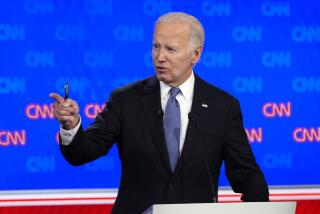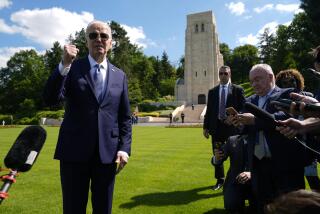After Slow Start, Alzheimer’s Research Gets a Big Push
WASHINGTON — Thirty years ago, no one talked much about Alzheimer’s disease -- its symptoms were seen as part of a psychological disorder or generic dementia. Twenty years ago, it gained enough notice that President Reagan designated an Alzheimer’s Disease Month. Ten years ago -- about the time Reagan was diagnosed with the disease -- the government was committing about $300 million a year to research, but not getting very far.
Today, there is an urgency about Alzheimer’s that puts it in the headlines almost daily.
The amount spent on research could soon climb to $1.4 billion a year. And what scientists can and cannot do as they search for a cure is at the center of a national ethics debate.
Reagan’s death last month has spurred lawmakers and advocates to say that more research into the ailment has never been more crucial, with scientists now poised to make major breakthroughs as more of the 77 million baby boomers approach retirement age.
The disease currently afflicts 4.5 million Americans and experts predict that number will triple by 2050.
“Certainly the moon and the stars are beginning to line up to give another increase to Alzheimer’s funding,” said Stephen McConnell, senior vice president for advocacy and public policy at the Alzheimer’s Assn., the world’s largest private funder of Alzheimer’s research.
Public support for Alzheimer’s research is so strong that it is renewing attention to the use of embryonic stem cells, which some researchers think could reap advances in the treatment of Alzheimer’s and other diseases.
Although some scientists acknowledge that the potential benefits of stem cell research for treating Alzheimer’s in particular -- as opposed to diabetes and Parkinson’s, for instance -- have been exaggerated to the public, Nancy Reagan’s emergence this spring as a supporter of stem cell research has ushered Alzheimer’s even further into the political limelight.
On June 16, less than two weeks after the former president’s death, a bipartisan group of lawmakers introduced the Ronald Reagan Alzheimer’s Breakthrough Act, which would double research funding from about $700 million annually to $1.4 billion. Sen. Barbara A. Mikulski (D-Md.), who lost her father to Alzheimer’s in 1987, called the initiative “a living memorial” to the former president.
“President Reagan lived his life with vigor. And we have to attack the Alzheimer’s situation with the same vigor,” she said.
A budget boost would provide relief to scientists at the National Institute on Aging, the primary NIH organization for research on Alzheimer’s, who say that lately the money for research keeps coming up short.
“We’re making very difficult decisions all the time. More than 80% of the [grant] applications that come into the institute aren’t funded,” said Marcelle Morrison-Bogorad, the National Institutes of Health’s associate director for neuroscience and neuropsychology of aging. “You worry that one of these grants is the one you ought to have funded.”
Funding for Alzheimer’s research for fiscal year 2005 is estimated at $700 million. By comparison, more than $5.7 billion is spent on cancer research and about $2.9 billion on HIV and AIDS research.
“The message of this big increase is: ‘Goodness, we have to do something about this problem,’ ” said Denis Evans, director of the Rush Institute for Healthy Aging in Chicago.
“We as a society are going to be in a lot of trouble if we don’t do something. This is a very persuasive argument for dealing with it now.”
Evans, who specializes in tabulating Alzheimer’s populations, said that about 440,000 Californians are living with the disease. By 2010, that number could increase to 480,000.
According to a report released June 23, Alzheimer’s could choke the economy unless the government invested more in research. Medicare beneficiaries with Alzheimer’s account for 34% of Medicare spending, but they make up only 12.8% of the population over age 65.
The study, sponsored by the Alzheimer’s Assn. and conducted by Lewin Group, a healthcare consulting firm in Falls Church, Va., showed that research breakthroughs could save $149 billion in Medicare and Medicaid costs by 2025 and result in nearly 3 million fewer Americans with the disease.
Morrison-Bogorad at NIH warns, though, that funding more research, although welcome, is about increasing the chance for a cure in the long term. Even clinical trials that are seeing promising results will not be completed until 2007 or 2008.
Nonetheless, techniques for diagnosing Alzheimer’s have improved in the last 15 years. The Centers for Medicare and Medicaid Services, part of the Department of Health and Human Services, announced June 15 that it would expand coverage of positron emission tomography, or PET, scans for those suspected of having Alzheimer’s if all other diagnostic tools had been exhausted.
Although “the gold standard for diagnosis is autopsy,” said Dr. Sean Tunis, chief medical officer of the Medicare and Medicaid office, “a clinical evaluation, tests of mental function, a physical examination and a good clinical history of a patient’s pattern of symptoms are a highly accurate way of diagnosing the disease. PET scanning potentially adds a little more on top of that.”
In another convergence of events, there was a flurry of activity among advocates for stem cell research in the days just before Reagan’s death, suggesting that even without the revived attention on Alzheimer’s, public support for stem cell research had been growing.
On June 3, a California initiative that would fund $3 billion of embryonic stem cell research -- independent of NIH and the federal government -- qualified for the state’s November ballot.
On June 4, 58 senators, including 14 Republicans, wrote to President Bush, asking him to review his August 2001 decision to restrict embryonic stem cell research to a small number of existing cell lines. Their letter mirrored one sent two months earlier by 206 House members.
Stem cells are coveted for their ability to develop into many different cell types, which is why scientists think such research could shed light on a wide array of illnesses, and an April 2004 poll by Peter D. Hart Research Associates indicated that nearly all Americans had a personal connection to at least one of them.
Another Hart survey conducted in the days after Reagan’s death showed that 72% of respondents were more likely to support stem cell research, including 64% of conservatives.
Picking up on the widening support for stem cell research, the presumed Democratic presidential nominee, Sen. John F. Kerry of Massachusetts, has invoked Reagan’s name at campaign stops.
“As America said goodbye to Ronald Reagan, we also honored the devotion and love of his wife, Nancy. Her pleas for stem cell research joined the pleas of millions across this country and reinforces in all of us the need to tear down every wall today that keeps us from finding the cures of tomorrow,’ Kerry said June 21 at a stop in Colorado.
Two days later, 142 patient groups, universities and scientific societies sent yet another letter to Bush, and senators introduced a bill to expand the federal policy on stem cell research.
And on July 4, Sen. Orrin G. Hatch (R-Utah), a strong supporter of stem cell research, noted that there were moves toward a compromise on the administration’s stem cell policy.
“I think that the Bush administration and all of us will get together and try to find some way that this great research can go on,” Hatch told CNN’s “Late Edition,” noting that more than 60 senators were prepared to vote in support of expanded embryonic stem cell research.
“We need to support this,” he said. “Nancy Reagan happens to be right on this.”
During his first term as president, Reagan designated November as Alzheimer’s Disease Month. “The emotional, financial and social consequences of Alzheimer’s disease are so devastating that it deserves special attention,” Reagan wrote in 1983, more than a decade before his own diagnosis. “Right now, research is the only hope for victims and families.”






